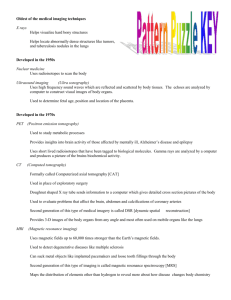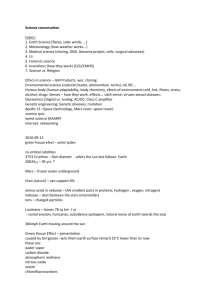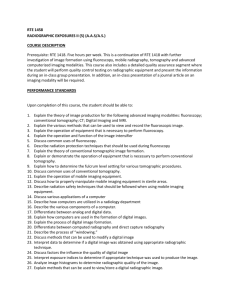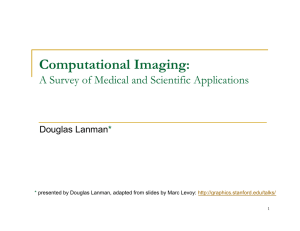DIAGNOSTIC PROCEDURES
advertisement
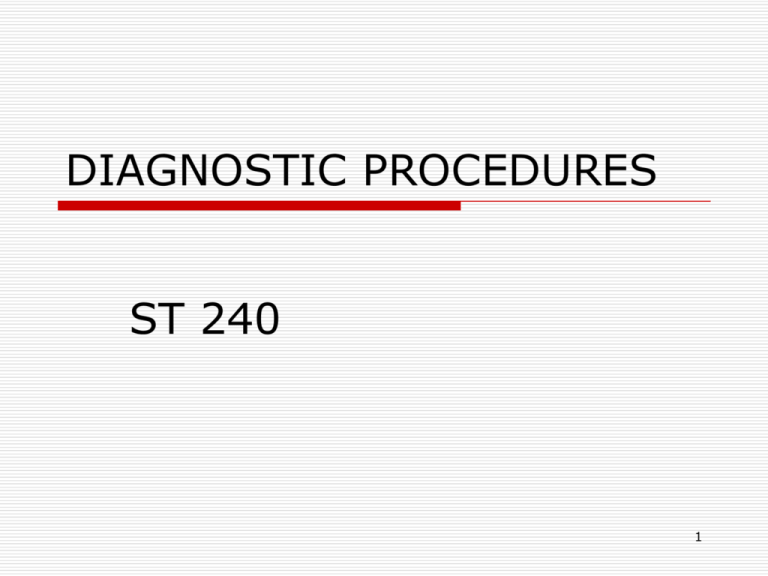
DIAGNOSTIC PROCEDURES ST 240 1 Etiology The study of ALL factors that may be involved in the development of a disease 2 SOURCES OF PATIENT DATA H&P IMAGING LAB FINDINGS ELECTRODIAGNOSTIC STUDIES ENDOSCOPIC PULMONARY DX 3 HISTORY AND PHYSICAL First step of Etiology Medical, social, psychological, family Physical examination – should include all body systems Height, weight, temperature, pulse, respiration, blood pressure All surgery patients must have an H&P in their records before taken into the O R 4 DIAGNOSTIC IMAGING Radiography p. 372 Fluoroscopy p. 373 Angiography Heart Catheterization Cholangiography p. 376 Computed Axial Tomography ( CAT scan) Magnetic Resonance Imaging ( MRI ) Ultrasonography Doppler Ultrasonography Isotope Scanning 5 Radiography ID the location of abnormalities and F.B. Locate retained sponges, sharps, or instruments Discover fluid or air within the body Verify the correct location for an operative procedure Aid in bone reduction or prosthesis placement Verify placement of indwelling catheters, tubes, and drains 6 ID the location of abnormalities and F.B. 7 Verify the correct location for an operative procedure 8 Aid in bone reduction or prosthesis placement AP view Lateral view 9 Verify placement of indwelling catheters, tubes, and drains 10 Locate retained sponges, sharps, or instruments 11 Discover fluid or air within the body 12 Mammography 13 Myelogram 14 Fluoroscopy 15 Cholangiogram 16 Angiogram – peripheral 17 Cardiac Catheterization 18 Computed Tomography (CT scan) 19 Magnetic Resonance Imaging (MRI) 20 Positron emission tomography 21 Ultrasonography 22 Doppler 23 Isotope scanning 24 Lab reports 25 H&H Hemoglobin – protein-iron compound in the blood that carries oxygen to the cells from the lungs and carbon dioxide away from the cells to the lungs Hematocrit – a measure of the packed cell volume of red cells 26 Hematological studies – Values p379 table 13-1 Hemoglobin - Male 13.5 to 18g/dL Female 11.5 to 15.5g/dL Hematocrit – Male 40-52% Female 35-46% Platelets – 130 to 400 WBC – 5,000 to 10,000 Coagulation – 5 to 15 minutes 27 Urinalysis -Values p 380 table 13-2 A clean-catch is used Color – light straw to dark amber pH – 4.5 to 8.0 (average 6) Glucose – negative 28 Tissue specimens Needle aspiration – needle and syringe Incisional biopsy – partial of lesion Excisional biopsy - entire tumor Frozen Section – for immediate dx; no formalin Permanent section – for final dx, 24 hrs; placed in formalin Orientation and Margins are important 29 Bacteriologic tests Culture and sensitivity – aerobic and anaerobic Taken with cotton-tipped applicator Special care should be used with the anaerobic culture Taken under sterile conditions and before antibiotic therapy Gram stain – a way to ID bacteria 30 Electrocardiography Used to record and study the electrical activity of the heart 3 lead for typical surgeries; 5 lead for more extensive surgeries Holter monitor is used to monitor a person’s heart for a 24 hour period 31 Electroencephalography Used to record and study the electrical activity of the brain Used during cranial, spinal, and vascular procedures for monitoring of neurological function Can be used to determine the area of the brain affected by a tumor 32 Electromyography Used to record and study the electrical activity of skeletal muscle 33 Pulmonary Diagnosis Pulse oximetry – arterial saturation of hemoglobin with oxygen is measured by passing a light through the tissues Capnography – used to estimate arterial levels of carbon dioxide (endtidal CO2) Spirometry – used to evaluate the patient’s respiratory status; lung capacity, resistance, and vent pressure 34 Plethysmography and Phleborheography Used to record variations in the blood volume and variations of a body part or extremity Can be used to diagnose DVT 35 ENDOSCOPY Used for DX, BX, therapeutic purposes Arthroscopy Laparoscopy Thoracoscopy Bronchoscopy Laryngoscopy Colonoscopy 36 ENDOSCOPY cont. Gastroscopy Hysteroscopy Sinusoscopy Otoscopy Cystoscopy – resectoscope Choledochoscopy Mediastinoscopy Ureteroscopy Angioscopy 37

